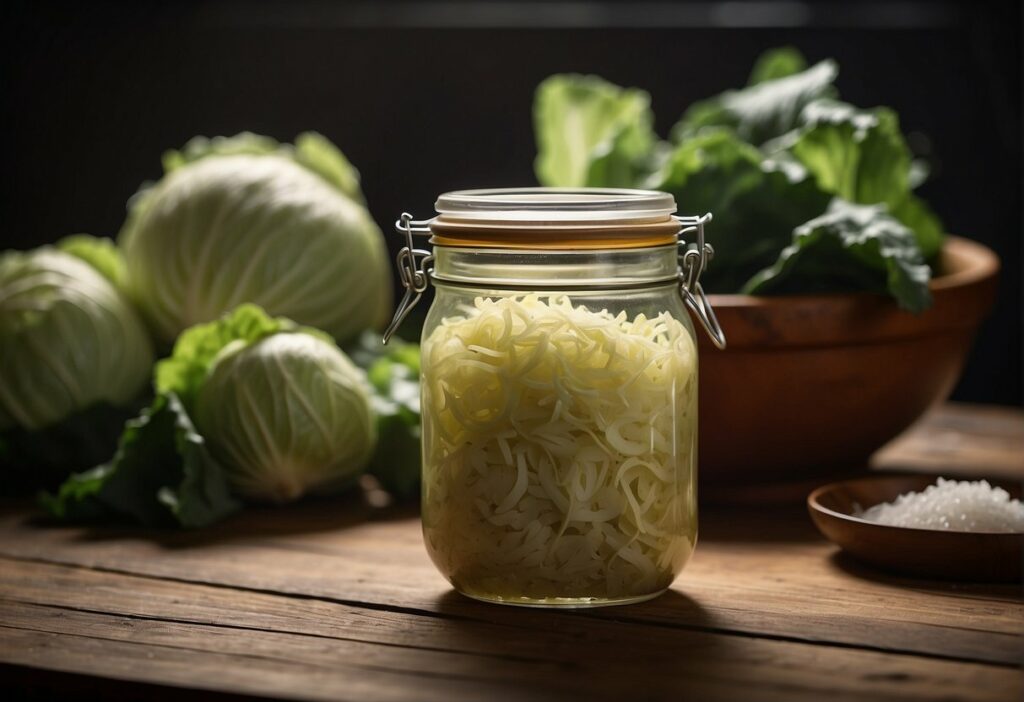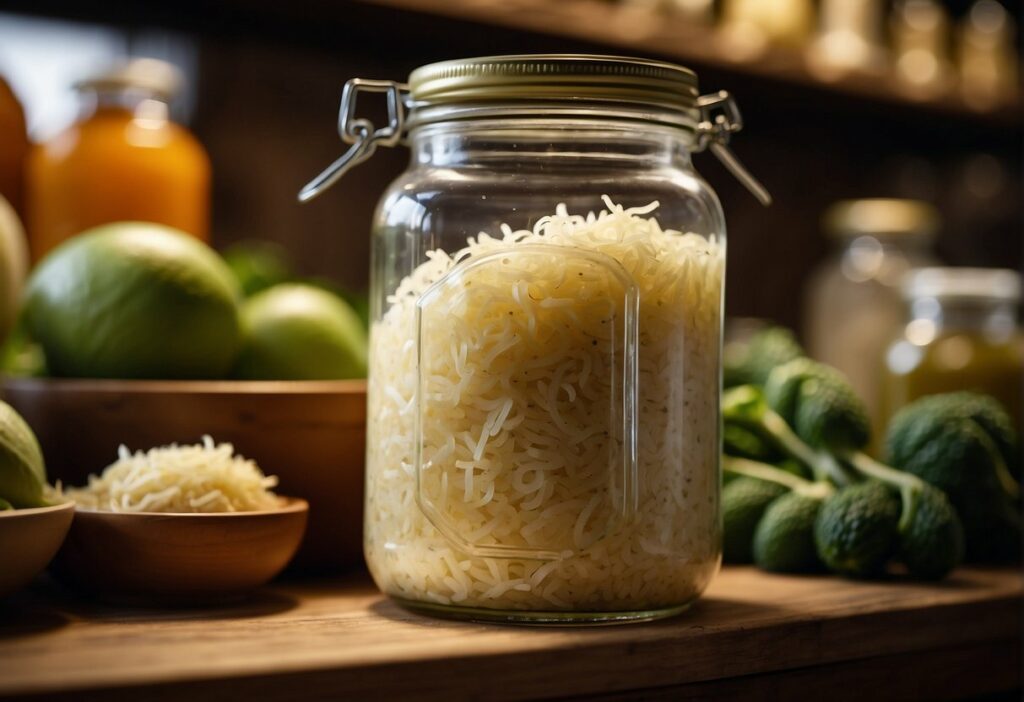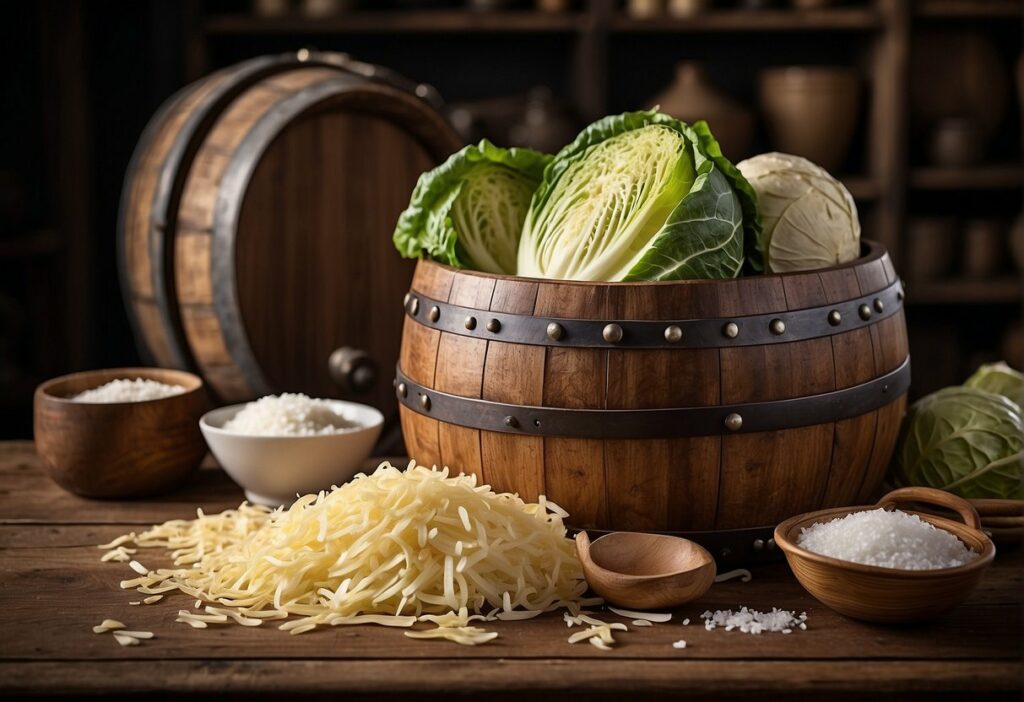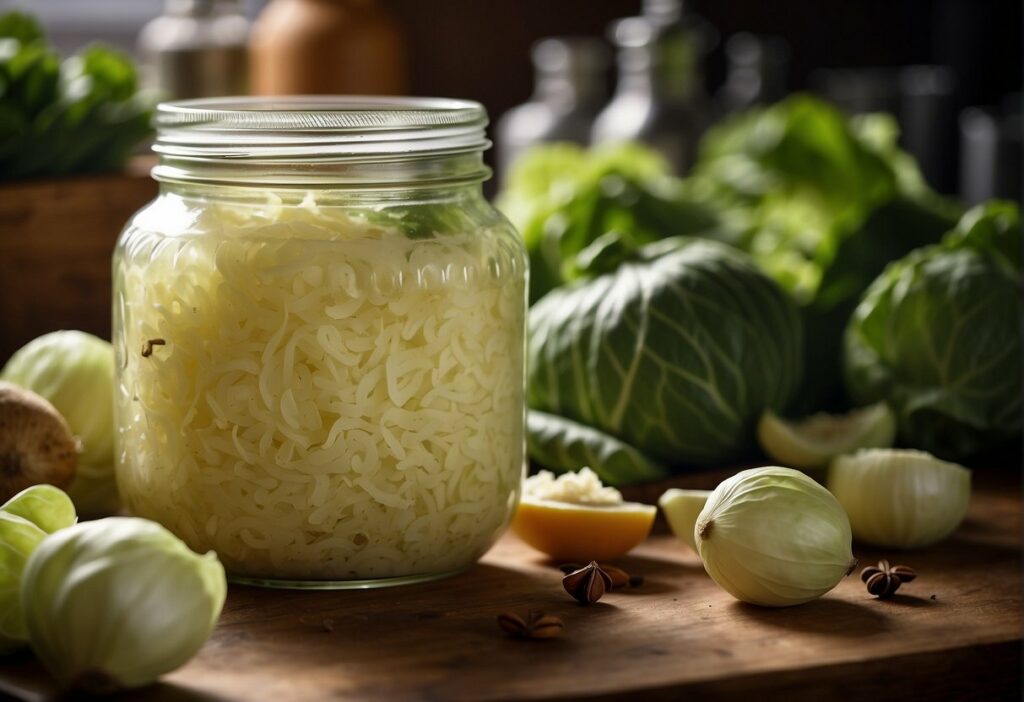Sauerkraut is a traditional food that has graced tables for centuries, commonly associated with German cuisine but enjoyed worldwide. At the heart of the matter, sauerkraut is fermented. The process of making sauerkraut involves shredding cabbage which is then layered with salt and left to ferment through lactic acid fermentation. This microbial process is distinct from pickling, which relies on soaking food in vinegar or a similar acidic liquid. While sauerkraut is sometimes discussed in the context of pickled foods, its creation does not involve an added acid but rather depends on the natural bacteria present on the cabbage to produce the sour taste characteristic of fermented foods.

The method by which sauerkraut is made not only imparts it with a unique tang but also enriches it with probiotics, making it a food that supports digestive health. The fermentation process produces live cultures that are beneficial for the gut, a feature that traditional vinegar-based pickling does not offer. Beyond its probiotic content, sauerkraut is also valued for its nutritional profile, being low in calories and high in vitamins C and K. Additionally, the fermentation process may increase the bioavailability of some nutrients, making sauerkraut a nutritious addition to a variety of meals.
As for storage, the very process that transforms cabbage into sauerkraut naturally preserves it, allowing it to be kept for extended periods under appropriate conditions. Traditionally, sauerkraut could be stored in a cool cellar or similarly chilled environment, but modern refrigeration extends its shelf life even further, keeping it fresh and ready to be enjoyed as a crunchy, flavorful topping or side.
Key Takeaways
- Sauerkraut is made through lactic acid fermentation, not through the pickling process.
- It offers probiotic health benefits and is rich in vitamins C and K.
- Properly fermented and stored sauerkraut has a long shelf life and can be enjoyed for several months.
Sauerkraut: Fermentation Basics
Sauerkraut is a form of naturally fermented food, primarily consisting of cabbage transformed by lactic acid bacteria. This traditional preservation method enhances both the flavor and the nutritional value of the vegetables.
Understanding Fermentation
Fermentation is a metabolic process in which microorganisms convert carbohydrates, like sugar, into alcohol or acids. In the context of sauerkraut, lactic acid fermentation is the key reaction. This process involves lactic acid bacteria, most notably from the genera Lactobacillus, consuming the sugars present in the cabbage and producing lactic acid as a by-product. The growing acidity creates an environment that preserves the cabbage, producing the distinct tangy flavor and improved digestibility of sauerkraut.
Key Components of Sauerkraut Fermentation
To successfully ferment cabbage into sauerkraut, three main components are essential:
- Cabbage: The base vegetable, shredded and prepared for fermenting.
- Beneficial Bacteria: Naturally found on the cabbage leaves, these bacteria are essential for initiating the fermentation process.
- Fermentation Container: An anaerobic environment is necessary, usually achieved in a container such as a jar or crock, which can be sealed to keep oxygen out and maintain a controlled environment.
The fermentation of sauerkraut does not involve vinegar or heat; instead, it relies entirely on the process of these beneficial bacteria breaking down the natural sugars in cabbage. The result is a fermented food rich in probiotics, known for their positive health effects.
The Role of Salt in Fermentation
Salt plays a crucial role in kraut fermentation. It helps to:
- Draw out water from the cabbage, creating a brine in which fermentation occurs.
- Regulate the growth of bacteria, favoring the growth of lactic acid bacteria over harmful bacteria.
The ratio of salt to cabbage is critical, as too much salt can inhibit fermentation and too little can allow the growth of undesirable bacteria. Typically, a salt concentration of around 2% to 2.5% is ideal for proper sauerkraut fermentation. The presence of salt, together with the lactic acid that forms, ensures that the fermenting cabbage can mature into crisp, flavorful, and naturally preserved sauerkraut.
Health Benefits and Nutritional Profile
Sauerkraut is recognized for its unique combination of providing probiotics, essential vitamins, minerals, and aiding digestion. Its fermentation process enhances its nutritional benefits, making it a healthful addition to one’s diet.
Probiotics and Gut Health
Sauerkraut is a rich source of probiotics, specifically lactic acid bacteria such as Lactobacillus. These bacteria are beneficial for gut health, as they help balance the gut microbiome. This balance is crucial for enhancing digestive health and can support the immune system.
Vitamins and Nutrients in Sauerkraut
A serving of sauerkraut is packed with essential nutrients, notably:
- Vitamin C: An antioxidant that is involved in tissue repair and immune function.
- Vitamin K: Key for blood clotting and bone health.
- Vitamin B6 and Folate: Important for energy metabolism and red blood cell formation.
- Iron: Essential for transporting oxygen throughout the body.
The fermentation process can increase the bioavailability of these nutrients, making them easier for the body to absorb.
Sauerkraut in Diet and Digestion
Incorporating sauerkraut into the diet may improve digestion due to its dietary fiber content and the presence of enzymes that aid in breaking down carbohydrates. The nutritional benefits of sauerkraut also include its low-calorie profile and potential to enhance the digestibility of other foods, thanks to the probiotics it contains.
Sauerkraut Preservation and Storage

Sauerkraut, a type of fermented vegetable, requires proper storage to maintain its quality and flavorful profile. This section provides a detailed look into the storage conditions and shelf life, as well as the distinctions between raw and pasteurized forms.
Shelf Life and Storage Conditions
-
Fermented Sauerkraut: The shelf life of properly fermented sauerkraut can extend to several months when stored in the refrigerator section. Optimal conditions involve keeping it at cool temperatures in an airtight container to prevent spoilage.
Storage Method Temperature Expected Shelf Life Refrigeration 32°F – 40°F (0°C – 4°C) Several months Freezing 0°F (-18°C) or below 12 to 18 months Canning Varies Check canning guidelines -
Heat Sensitivity: It is important for individuals to store sauerkraut in conditions away from high heat. Temperatures above 80°F (26°C) may cause it to become soft and spoil, whereas sauerkraut stored below 60°F (15°C) may not ferment properly.
Difference Between Raw and Pasteurized Sauerkraut
-
Raw Sauerkraut: This form is uncooked and full of live bacteria because of the fermentation process, where shredded cabbage is transformed by the presence of sodium into sauerkraut. To ensure preservation of the probiotic content, individuals must store it under refrigeration.
-
Pasteurized Sauerkraut: Pasteurized sauerkraut has been heat-treated to kill bacteria and, as a result, has a longer shelf life. Despite this, it should still be stored in the refrigerator to prolong freshness, although it lacks the active bacterial cultures found in the raw version.
Cultural and Historical Aspects

Sauerkraut’s place in culinary traditions is steeped in a rich history where fermentation was not just for flavor but also an essential preservation method.
Traditional Sauerkraut in Various Cultures
German Sauerkraut: In German cuisine, sauerkraut is the result of cabbage fermented by various strains of lactic acid bacteria, a process that has been central to German food culture. It is a staple that has been enjoyed alongside dishes such as bratwurst and pork.
- Kimchi in Korea: While not the same as sauerkraut, Korea’s kimchi shares the fermentation process, with its history spanning millennia. Notably spicier, kimchi incorporates cabbage among other ingredients, making it a fundamental part of Korean cuisine.
Historical Significance of Fermented Foods
Preservation Technique: The practice of fermenting foods like sauerkraut predates refrigeration and canning, providing a means for long-term preservation of nutrients through the prolonged shelf life of fermented goods. This was particularly crucial during seasonal shortages and long sea voyages.
- Genghis Khan and Spread of Sauerkraut: It is believed that sauerkraut made its way to Europe in the bags of invading Mongol hordes under Genghis Khan, after originating in China where it was a staple for building the Great Wall. These nomadic warriors helped spread the method of cabbage fermentation, which evolved into sauerkraut as it is known in the West.
Table 1: Comparison of Sauerkraut and Kimchi
| Feature | Sauerkraut | Kimchi |
|---|---|---|
| Origin | Europe (Germany) | Asia (Korea) |
| Main Ingredient | Cabbage | Cabbage and other vegetables |
| Spices | Typically milder | Generally spicy |
| Fermentation Agent | Lactic acid bacteria | Lactic acid bacteria |
| Traditionally Served With | Sausages, pork | Rice, soups |
Fermented foods like sauerkraut have played a vital role in human diet and culture, carrying nutritional and historical importance through epochs of human civilization.
Frequently Asked Questions

In this section, we address common inquiries about the differences and characteristics of fermented and pickled foods, specifically sauerkraut, and its presence in grocery stores.
What are the health benefits of fermented versus pickled foods?
Fermented foods, like sauerkraut, are renowned for their probiotic content which can aid in digestion and enhance gut health. Pickled foods are preserved primarily in vinegar and do not typically provide the same probiotic benefits.
How can one distinguish between pickled and fermented foods?
Pickled foods have been preserved in an acidic medium like vinegar, often with added seasonings, while fermented foods rely on natural bacteria or added cultures to produce acids that preserve and flavor the food.
Are there differences in probiotic content between pickles and sauerkraut?
Yes, there are differences. Sauerkraut that is fermented contains live probiotics due to the fermentation process. Pickled foods, unless fermented before being pickled, generally do not contain these live cultures.
Can you find fermented sauerkraut in grocery stores?
Fermented sauerkraut is available in grocery stores, often found in refrigerated sections to maintain the viability of probiotics, as opposed to shelf-stable, pasteurized options that may not contain live probiotics.
What are the characteristics of sauerkraut to indicate it has been fermented?
Fermented sauerkraut typically has a tangy flavor, natural sourness, and can often be identified by the presence of live bacteria cultures on the product label, suggesting it has undergone natural fermentation.
Do all types of sauerkraut undergo a natural fermentation process?
Not all sauerkraut on the market has undergone natural fermentation. Some sauerkraut products are made by a quick pickling process using vinegar, which does not yield the same probiotic-rich food as natural fermentation does.